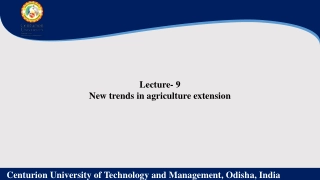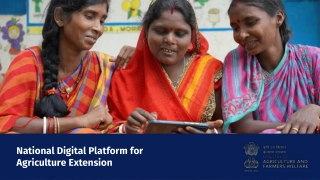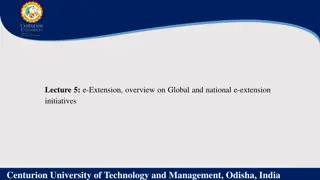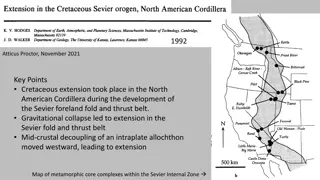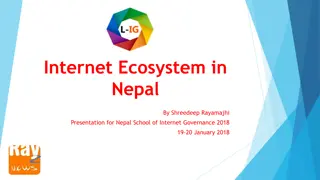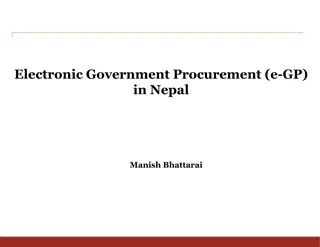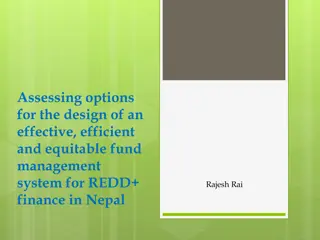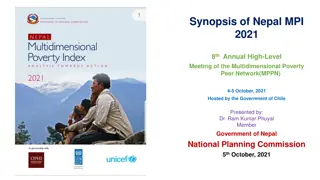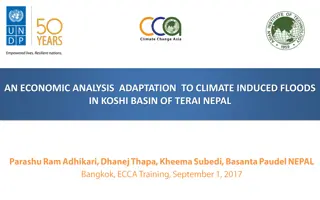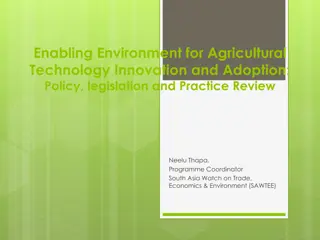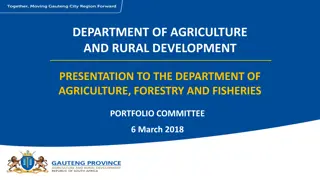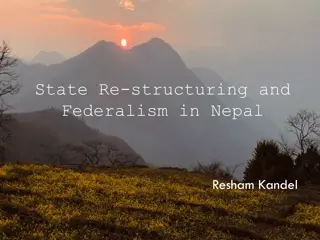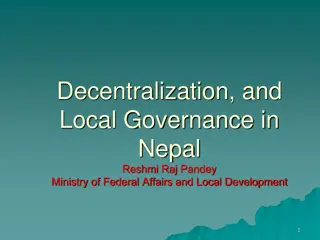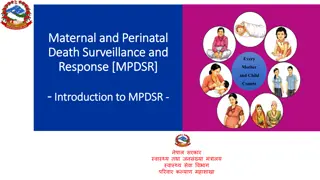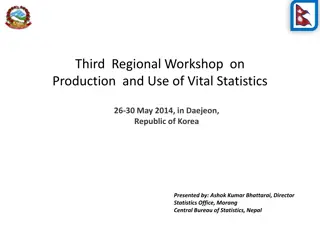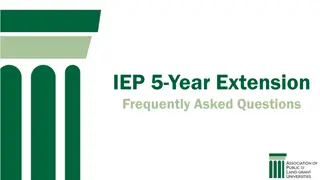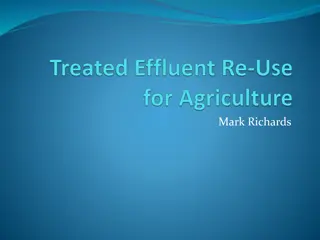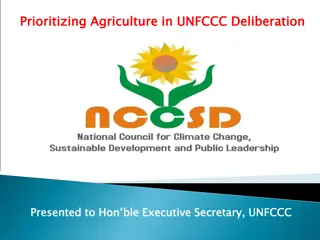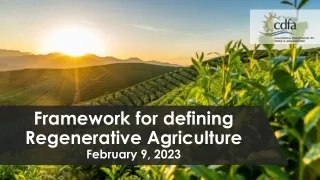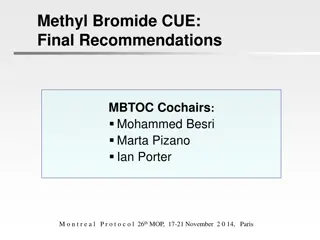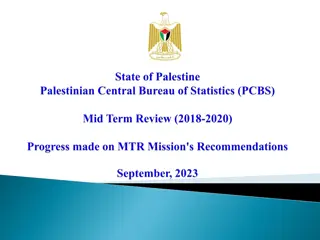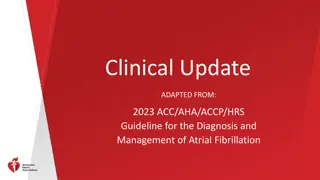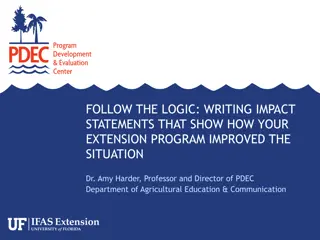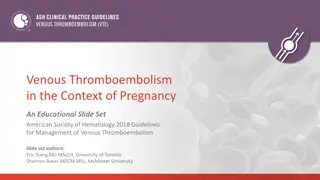Enhancing Agriculture Extension Services in Nepal: Recommendations and Challenges
This project focuses on improving agriculture extension services in Nepal, particularly in Province 2. It addresses current gaps and issues in the extension approaches, highlighting the need for better linkages, qualified human resources, and enhanced infrastructure. Recommendations from past research emphasize the importance of increasing the number of frontline extension workers, enhancing their skills, and strengthening monitoring mechanisms.
Download Presentation

Please find below an Image/Link to download the presentation.
The content on the website is provided AS IS for your information and personal use only. It may not be sold, licensed, or shared on other websites without obtaining consent from the author. Download presentation by click this link. If you encounter any issues during the download, it is possible that the publisher has removed the file from their server.
E N D
Presentation Transcript
Centre for Green Economy Development - Nepal Community Development & Advocacy Forum Nepal-CDAFN PILOT PROJECT: Knowledge Transfer Mechanisms for Effective Agriculture Extension Service Delivery to Farmers in Province 2 Madhav Karki, Ph.D. Executive Director, CGED-Nepal & Team Leader Adjunct Professor, Institute of Forestry, Tribhuwan University, Nepal
Outline Current Situation of Agriculture Extension ( Approaches and Gaps) Recommendation of past research Research Objectives & Methodology Research Activities Progress to Date Learning gained so far
REVIEW OF DoA- EXTENSION APPROACHES (Credit: Sunilkumar Singh, DoA) Current Agri. Extension Approaches at present Conventional Educational Approach- Pocket Package Approach- Projectisation Approach- Farmers Group Approach- Farmers Field School Approach- Partnership Approach- Value Chain Subsidy Approach- 3
CURRENT ISSUES AND GAPS IN AGRICULTURE EXTENSION SERVICES OF NEPAL(Credit: Sunilkumar Singh, DoA) contd . Lack of motivation among the Frontline Extension workers and farmers, Inadequate number of the extension workers and their qualification and skills, Inadequate infrastructure and capacity for use of ICTs among the ground level extension workers, Lack of monitoring and assessment of impact of extension activities in rural farmers, 2011/04 4
CURRENT SERVICES OF NEPAL(Credit: Sunilkumar Singh, DoA) ISSUES AND GAPS IN AGRICULTURAL EXTENSION Ineffective and weak linkages between agencies and stakeholders at three levels of Government, Insufficient budget and investment for extension activities, Domination of supply driven approaches rather than demand driven services, Inadequate extension services in areas such as value addition and market exposure, 2011/04 5
Recommendations of Previous Research in Province 2 Recruit adequate and qualified human resources in both province and local levels. Enhance the capacity and motivation of agriculture personnel especially in local government levels. Increase the frontline extension worker per farm household to cater extension service delivery adequately. Operationalize ASC with regular government budget and improved technical capacity
Create Enabling Environment in Provincial and Local Level Agricultural Extension Offices Engage youths in agriculture through motivation, financial incentives, increased investment, rural infrastructures, greater use of ICT and social media in education, information and communication. Improve total factor productivity (TFP) through intensification of agriculture and increase market access. Protect agriculture land from the impact of climate change and implement climate adaptation and disaster risk management to improve resilience.
Objectives of Current Research Overall: to explore the opportunities for improving coordination mechanisms between different government agricultural agencies, for developing co-operative agriculture extension service to improve food and nutrition security. Specifics: Document the potential knowledge systems that are relevant to Krishi Gyan Kendras (KGKs); Understand how provincial and municipal governments are responding to the growing impact of Covid19 on the province s food security; Conduct knowledge-policy dialogues and interactions between AKCs with select municipalities to develop working mechanisms in agri-extension work; Produce and disseminate extension (information, communication and education or ICE) materials; Use the learning for better adapting and mitigating the impact of climate, pandemic and poverty challenges.
Action Research Methods Knowledge, Capacity, Research Gap analysis: Gap analysis is a process that compares the actual performance with what was expected; Knowledge Communication (two-way): to make knowledge and good practice more accessible to KGK and municipalities (thru research navigators, research-extension bridging, knowledge translator and gap filler in the knowledge to practice chain). Shared learning dialogue: Sequence of meetings among stakeholders to co-develop the process of a suitable co-operative extension service for meeting new challenges confronting food system in P2.
Progress to date Inception cum Stakeholder Consultation Workshop (objective was to map the institutions and their potential role and contribution); Extension service need and aspiration survey of farmers ; Participation in National Food System Conference
Types of interest and needs for agriculture inputs and services among farmers
Farmers expectations from and concerns about Commercialization of agriculture
Learning gained so far..contd.. The local government elected officials identified main barriers as: a) unclear role and responsibilities of the local government; and b) lack of trained human resources with poor technical and practical capacity; The provincial government feels that the power and responsibilities given to AKCs are not utilized effectively in agriculture extension service delivery system;
Learning gained so far.. Although the survey was done only in 3 wards of Bardibas NP, agriculture is a major source of income in the entire research area and the province 2. Marketing of the agricultural products is directly to the customers. The age group category of farmers is predominantly male comprising youth and middle age adults.


